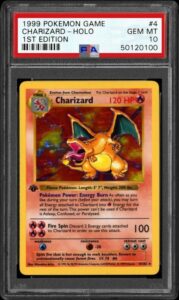
The Pokémon cards craze in the late 1990s and early 2000s was impossible to ignore for kids and parents alike, but for many it wasn’t an enduring phenomenon. As a result, families across the nation have Pokémon cards tucked away in their basements and self storage units. Two decades later, it’s natural to ask the big question: Are Pokémon cards worth any money? And how can I properly store Pokémon cards for the long term? The answer may surprise you—but don’t start counting that money just yet.
How Much are Pokémon Cards Worth?
How much you can sell your Pokémon cards for is mostly dependent on three variables: the card’s rarity, which print edition the card came from, and the card’s physical quality. Holo Pokémon cards are worth more than standard cards.
It’s important to note that your average Pokémon collection won’t make you rich. As of 2024, an analysis of online Pokémon card prices reveals that most common and uncommon cards are worth less than $1, and rare cards are worth less than $10. However, the market price for holographic Pokémon cards usually range from $10 to $50, with the most expensive card in a set often reaching $100 or more.
How Much is an Old Pokémon Card Worth?
Most of the time, when people talk about “old” Pokémon cards, they’re referring to the first three Pokémon sets released in 1999 in the United States: Base Set, Jungle Set, and Fossil Set. Older Pokémon cards in these sets from first edition printings can sell for tens or hundreds of thousands of dollars, but even non-first edition holographic cards from these sets can go for a lot of money. Arguably the most famous Pokemon card of all time, the holographic Charizard from the base set, has a market price of over $350 as of 2024.
How to Research Pokémon Card Prices
If you’re looking to maximize your return on selling your Pokémon cards, you will need to do your research. Blindly selling individual cards without doing the legwork on Pokémon card value could end up selling yourself short —and giving a collector a great deal.
The best way to research Pokémon card prices is to look at real life selling history. After all, Pokémon cards are only worth what someone is willing to pay. Check out these three resources to see what your Pokémon cards are worth:
- eBay has the largest collection of Pokémon cards for sale online.
- Pokemonprice.com has a variety of analytics metrics, including First Edition set price data over time.
- TCGPlayer is an online store for buying and selling trading cards, with card prices that reflect the average sale price of said cards within the TCGPlayer store.
If you have a lot of Pokémon cards but don’t want to go through the hassle of selling individual items, there are places where you can sell Pokémon cards in bulk. Just know that you’ll be leaving money on the table if you choose to go this route.
First Edition Cards Are King
Pokémon cards that were released before Nintendo began distributing the trading card game were printed in two sets: first edition and unlimited. You can tell that a card is first edition because of the “Edition 1” badge located at the bottom-left of the card illustration.
Card Condition Is Important

The condition of your Pokémon cards is a vital part of whether they have any value. Collectors aren’t interested in ripped, stained, or otherwise defaced cards, and such wear can severely tank a card’s value even if it is a rare one.
You’ve probably heard of mint condition cards before. If you’re wondering whether or not a card qualifies as mint, you’ll need to get it graded by a PSA (Professional Sports Authenticator) representative. Your card could be worth more if you have its condition officially graded. However, it costs money to get your card graded by a professional, so you should only do so if you are sure that your card is worth at least the money it will take to be professionally graded.
Best Pokémon Card Storage Methods and Ideas
No matter if you’re interested in selling your Pokémon cards or keeping them, it’s important to know how to store them. If you’re interested in the former, properly storing your cards will maintain their value. And if even if you’re not interested in selling, you don’t want to ruin your belongings by improperly storing them.
Card Protection
Since Pokémon card quality is so important to their value, it’s important to keep each card protected. You should always store Pokémon cards inside individual sleeves if you want them to remain in their best condition. There are two main types of card sleeves:
- Penny sleeves—These thin, flexible, translucent sleeves mainly protect cards from dirt, stains, and oils. They are cheap (hence their name) and won’t guard against folding or creases.
- Toploaders—Constructed from rigid, translucent plastic, these sleeves protect against both dirt and grime as well as folds and creases.
For maximum Pokémon card protection, use both a penny sleeve and a toploader for each card. There are other kinds of card sleeves, too, such as matte card sleeves that cover the back of each trading card. However, penny sleeves and toploaders are the workhorses of trading card protection.
Pokémon Card Storage Box
Once you’ve put your Pokémon cards in their sleeves, you’ll need to put them in a box for easy safekeeping. One option is clear plastic boxes, which provide great protection and make it easy to see what kind of card you have inside. Another option is the classic 9-pocket page for three ring binders.
Looking for something a little less fancy? There are a wide variety of other options available on online storefronts, and there’s always cardboard boxes. Whichever Pokémon card storage box you decide on, make sure that it is elevated—either on a pallet or on a shelf—to guard against spills or other types of moisture on the ground.
Climate Controlled Storage
Pokémon cards, just like other trading cards, are made of cardstock, which is just a fancier and more durable kind of paper. As a result, Pokémon cards are susceptible to the types of things that can damage cardboard and paper—namely, extreme or rapidly changing temperatures as well as high humidity.
When storing your Pokémon cards—even if you’ve protected them in sleeves and in a box—you should do so in a climate controlled environment. At home, that means not storing them in the attic, your garage, or your shed out back if you’ve got one. You can store your Pokémon cards in the basement, but consider putting in a dehumidifier if it is particularly moist.
Another storage option is to find a climate controlled storage unit near you. These storage units can come in 5×5 or even locker sizes, meaning you don’t have to rent a giant unit just for a few items. Climate controlled storage units are kept at a consistent temperature range all year round, and while most aren’t specifically humidity controlled, indoor climate controlled units are usually well within the range of acceptable humidity for Pokémon card storage.
Store Your Cards in Self Storage
Central Self Storage is the perfect place to store your Pokémon cards and other collectibles. That’s because our climate controlled storage units are perfect for storing temperature sensitive belongings. With storage units across the United States, you can easily find a storage unit near you. Rent your climate controlled storage unit today.


